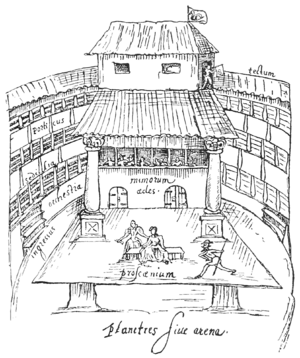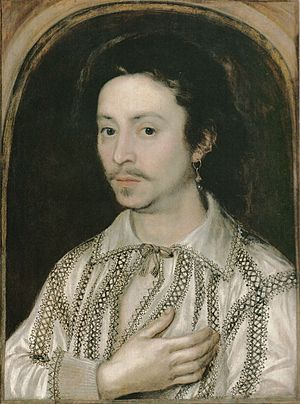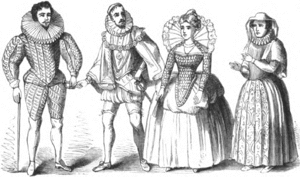English Renaissance theatre facts for kids
The English Renaissance theatre, also known as Elizabethan theatre, was a special time for plays in England. This period lasted from 1558 to 1642. Famous writers like William Shakespeare, Christopher Marlowe, and Ben Jonson created many amazing plays during this era.
Contents
- What Was English Renaissance Theatre?
- Where Plays Were Performed
- Building Theatres
- Theatre Design
- Audiences and Tickets
- How Performances Worked
- Costumes in Plays
- Playwrights: The Writers
- Types of Plays
- Printed Plays
- The End of English Renaissance Theatre
- Important People in English Renaissance Theatre
- Images for kids
- See also
What Was English Renaissance Theatre?
This exciting period of theatre began around 1562. It followed a play called Gorboduc, which was the first English play to use a special kind of poetry called blank verse. The era ended in 1642 when the English Parliament decided to ban plays.
The term "Elizabethan" usually refers to the time when Queen Elizabeth I ruled (1558–1603). But the "English Renaissance theatre" period is wider. It includes:
- Elizabethan theatre (1562 to 1603)
- Jacobean theatre (1603 to 1625, during King James I's rule)
- Caroline theatre (1625 to 1642, during King Charles I's rule)
Over time, how plays were made and watched changed. At first, everyone, from the Queen to common people, watched the same plays in public theatres. Later, special "private theatres" appeared. These were for wealthier audiences, and the plays started to suit their tastes more. By the end of the period, fewer new plays were written for public theatres. They mostly showed older, popular plays.
Where Plays Were Performed
School Plays and Performances
Many schools in England, especially grammar schools, focused on teaching grammar, logic, and public speaking. Students learned skills like remembering lines and using their voice and body to perform. They would study old Latin and Greek plays, write their own, memorize them, and perform them for their teachers and classmates. Records show that students also performed plays in both Latin and English during holidays.
Choir School Performances
Choir schools connected to the Queen's court, like St. George’s Chapel and St. Paul’s, also put on plays. These schools often performed for the Queen. By the 1560s and 1570s, these boy choirs started performing for the general public too. Famous writers like John Lyly and Ben Jonson wrote plays specifically for these boy acting groups.
University Drama
Plays were also a big part of university life, especially at Oxford and Cambridge. In the 1400s, plays were often simple "mummer plays" where one person read all the parts in Latin. As old Latin and Greek texts were rediscovered, these classical plays were performed again, often with big feasts. Even Queen Elizabeth I watched plays when she visited Oxford and Cambridge.
Inns of Court Performances
After university, many students, especially those studying law, lived and worked at the Inns of Court. These were like communities for lawyers and university graduates. Many famous writers and playwrights lived there, including John Donne and Francis Bacon. Like universities, the Inns of Court had their own traditions, including plays and special masked performances called masques. Famous plays like Gorboduc were performed here. Even Shakespeare's The Comedy of Errors and Twelfth Night were performed at the Inns of Court, even though they were written for public theatres.
Building Theatres
The very first permanent English theatre, the Red Lion, opened in 1567 but didn't last long. The first truly successful theatres, like The Theatre, opened in 1576.
These large public theatres were very important for English Renaissance drama. They made theatre a regular and lasting part of life. Their construction happened because the Mayor of London banned plays in the city in 1572 due to the plague. This forced theatre groups to build permanent playhouses just outside London's control.
The Theatre was built in Shoreditch in 1576 by James Burbage. Soon after, other famous theatres followed:
- The Curtain Theatre (1577)
- The Rose (1587)
- The Swan (1595)
- The Globe (1599)
- The Fortune (1600)
- The Red Bull (1604)
Around this time, a law called the Vagabonds Act 1572 made it risky for actors to travel without a sponsor. This led actors to seek wealthy people who could support them and provide a permanent theatre. Rich families also found it useful to have their own acting groups to entertain guests and boost their social standing.
Theatre Design
Archaeological digs of the Rose and Globe theatres show that while each theatre was unique, they shared a similar basic design. Public theatres were usually three stories high and built around an open central space. They were often shaped like polygons (many-sided shapes) to give a rounded look, though some, like the Red Bull, were square.
The three levels of seating galleries faced inward, looking down onto the stage. The stage itself was a platform that stuck out into the audience, surrounded on three sides by spectators. The back of the stage was used for actors to enter and exit, and for musicians. The upper level behind the stage could be a balcony, like in Romeo and Juliet, or a place for an actor to speak to a crowd, as in Julius Caesar. The "pit" was the open area on the ground floor where the cheapest tickets were sold.
These playhouses were usually built with wood and plaster. They were designed to hold many people.
A different type of theatre appeared with the Blackfriars Theatre, which opened in 1599. The Blackfriars was smaller and had a roof, unlike the open-air theatres. It was more like modern theatres. Other small, enclosed theatres followed, such as the Whitefriars (1608) and the Cockpit (1617). By 1629, London had six theatres: three large open-air public theatres (the Globe, Fortune, and Red Bull) and three smaller, enclosed private theatres (the Blackfriars, Cockpit, and Salisbury Court). Audiences in the 1630s could enjoy both classic plays by Marlowe and Shakespeare and new works by current playwrights.
Audiences and Tickets
Around 1580, London's theatres could hold about 5,000 people. By 1610, with new theatres and acting groups, this capacity grew to over 10,000.
Ticket prices varied. The cost depended on where you wanted to sit and what you could afford. If you wanted a better view or more privacy, you paid more. Due to rising costs at the time, some theatre tickets increased from one penny to sixpence or even higher.
Most commercial theatres were located just outside the City of London because city officials were often cautious about acting companies. However, touring groups performed plays all over England. English companies even traveled and performed in other countries, especially in Germany and Denmark.
Wealthy audience members would pay for seats in the galleries, often using cushions for comfort. At the Globe Theatre, nobles could even sit right on the side of the stage.
How Performances Worked
Acting companies used a "repertory system." This means they rarely performed the same play two days in a row. Unlike today's shows that run for months, these troupes had a different play almost every day. For example, in 1592, Lord Strange's Men performed 23 different plays in just over four months. They never played the same play twice in a row. This meant actors, especially the main ones like Richard Burbage and Edward Alleyn, had to learn many different roles very quickly.
A unique feature of these companies was that only men and boys performed. Female roles were played by teenage boy players dressed in women's costumes. Some companies were made up entirely of boy actors. Public theatre performances (like at the Globe) happened in the afternoon using natural light. If it got dark during a play, candles were lit. In enclosed private theatres (like the Blackfriars), artificial lighting was used throughout. Plays had very little scenery; the setting was described by the actors or shown through their costumes.
Actors in the Elizabethan era were all male. The youngest boys played female parts. More experienced older boys took on stronger female roles in tragedies. Boy actors needed skills like a good voice and athleticism, including fencing.
Acting groups, called troupes, traveled around England. They were paid to constantly learn new plays as they toured. Sometimes, a "bookkeeper" would act as a narrator, introducing actors and their roles. Often, the audience had to figure out the story for themselves. Because plays often had more characters than actors, actors would "double roles," meaning one actor played several different parts. This helped companies save money on salaries and perform with fewer actors.
There were two main acting styles: formal and natural. Formal acting was traditional and symbolic. Natural acting tried to create a realistic illusion for the audience by staying in character. Formal actors represented a role, while natural actors tried to become the character. These different styles and the use of doubled roles made Elizabethan plays very popular.
Costumes in Plays
Costumes were very important in Elizabethan theatre because there wasn't much scenery or props. They created a strong visual effect for the audience. Costumes were often bright and eye-catching. Colors and fabrics showed a character's social status. For example, purple often meant royalty. So, when a character first appeared, the audience could tell their status just by their clothes.
Theatre companies kept a stock of costumes. They usually reused costumes and rarely made new ones because they were expensive. Actors often wore clothes that looked like what people wore every day, even if the play was set in a different time. The most expensive costumes were given to high-class characters to show their wealth. The quality of fabrics used in a playhouse also showed how rich the company was. Common fabrics included velvet, satin, silk, and lace. For less important characters, actors might even use their own clothes.
Actors sometimes left clothes to other actors in their wills. Masters also left clothes to their servants, but servants weren't allowed to wear fancy clothes. Instead, they often sold them to theatre companies.
During the Tudor and Elizabethan times, there were laws about what different social classes could wear. Higher classes showed off their wealth through their clothing. However, actors were an exception. They were allowed to dress above their social standing for specific roles, but only while they were working.
Playwrights: The Writers
London's growing population and wealth, along with people's love for entertainment, led to many amazing plays. About 3,000 plays were written for the Elizabethan stage, but most are now lost. Still, at least 543 plays from this time survive.
The people who wrote these plays often came from humble backgrounds. Some went to Oxford or Cambridge universities, but many did not. While William Shakespeare and Ben Jonson were also actors, most playwrights after 1600 didn't act to earn money. Their lives were often difficult and short, like many people in that era. For example, Christopher Marlowe died in a fight, and Ben Jonson killed an actor in a duel. Some playwrights were probably soldiers.
Playwrights were usually paid in stages as they wrote. If their play was accepted, they also received the money from one day's performance. However, they didn't own the plays they wrote. Once a play was sold to a company, the company owned it. The playwright had no say in who acted, how it was performed, or if it was changed or published.
Being a playwright was tough and didn't pay much. Records show that around 1600, a playwright might earn only £6 or £7 per play. A writer working alone could usually produce at most two plays a year. Shakespeare wrote fewer than 40 plays in over two decades. He became successful because he was also an actor and, importantly, a part-owner of the acting company and the theatres they used. Ben Jonson found success writing special masked performances for the King's court. Playwrights who only wrote plays, like George Peele and Robert Greene, often struggled financially.
To write more plays, playwrights often worked in teams of two, three, or even five. Most plays from this era were collaborations. Writers like Jonson and Shakespeare, who mostly worked alone, were the exceptions. Sharing the work meant sharing the money, but it seemed to be worth it. For example, Thomas Dekker worked on 16 plays with others in one year (1598) and earned about £30. This was roughly twice the income of an average worker at the time.
Types of Plays
Plays during this period covered many different genres:
- History plays showed English or European history. Shakespeare's plays about kings, like Richard III and Henry V, are examples. Christopher Marlowe's Edward II also fits this type.
- Tragedy was very popular. Marlowe's tragedies, such as Dr. Faustus and The Jew of Malta, were very successful. Audiences especially liked revenge dramas, like Thomas Kyd's The Spanish Tragedy. Shakespeare's greatest tragedies (Hamlet, Othello, King Lear, and Macbeth) were written then.
- Comedies were also common. A new type called "city comedy" appeared, which made fun of life in London. Examples include Thomas Dekker's The Shoemaker's Holiday.
Older play types like pastoral (plays about shepherds and country life) and even morality plays (plays teaching moral lessons) still had some influence. After about 1610, a new mixed type called tragicomedy became popular. The masque, a special court entertainment with music and dance, was also very popular during the reigns of King James I and King Charles I.
Plays based on stories from the Bible were also common. David and Bethsabe by George Peele is one of the few surviving examples.
Printed Plays
Only a small number of plays from the English Renaissance theatre were ever printed. For example, out of Thomas Heywood's 220 plays, only about 20 were published as books. In total, a little over 600 plays were published during this period, usually as individual small books. Larger collections of plays, like those of Shakespeare or Ben Jonson, came later and were less common.
For a long time, people thought that printed plays were very popular and made a lot of money for the publishers. However, more recent research suggests that publishing plays might have been a risky business. Some very successful publishers of the time rarely published plays.
A few plays from this era survived not as printed books, but as handwritten manuscripts.
The End of English Renaissance Theatre
The growing Puritan movement was against theatre, believing that "entertainment" was sinful. Playwrights and actors were often supported by the King and nobles, and most sided with the Royalist cause. The Puritans, who had a lot of power in London, took control of the city early in the First English Civil War. On September 2, 1642, the Long Parliament, influenced by the Puritans, banned plays in London theatres. They didn't order the theatres to be destroyed, but they did stop performances.
The ban was meant to be temporary, stating that "Public Stage Plays shall cease, and be forborn" while the country faced sad times and needed prayer. However, no end date was given.
Even after 1642, during the English Civil War and the time when England was a Commonwealth, some theatre continued. Short, funny plays called "drolls" were allowed, even though full-length plays were banned. The theatre buildings themselves weren't closed down but were used for other purposes.
Plays remained banned for most of the next 18 years. They were allowed again after the monarchy was brought back in 1660, a time known as the Restoration. Theatres began performing many of the old plays, often with some changes. New types of plays, like Restoration comedy, soon developed, giving English theatre of the late 1600s its own unique style.
Important People in English Renaissance Theatre
Playwrights
- William Shakespeare
- Christopher Marlowe
- Ben Jonson
- Thomas Kyd
- John Lyly
- George Peele
- Robert Greene
- Thomas Dekker
- Thomas Heywood
- John Fletcher
- Francis Beaumont
- Philip Massinger
- James Shirley
- John Webster
- Thomas Middleton
- John Ford
- Richard Brome
- George Chapman
- Anthony Munday
- John Marston
- William Rowley
Actors
Playhouses (Theatres)
Playing Companies (Acting Groups)
- The Lord Chamberlain's Men (later The King's Men)
- The Admiral's Men
- Queen Elizabeth's Men
- Lord Strange's Men
- Queen Anne's Men
- Queen Henrietta's Men
- The Children of Paul's
- The Children of the Chapel
Images for kids
See also
 In Spanish: Teatro isabelino para niños
In Spanish: Teatro isabelino para niños









